Conventional car
Simplifying to the maximum, any conventional car (that is not micro-hybrid, hybrid or electric) has four elements in its electrical system:
- Generator (Alternator)
- Battery
- Control electronics
- Consumers (starter motor, spark plugs, fans, windows, lights, radio, etc.).
The alternator will charge the battery when the car is running, the charge being managed by very basic control electronics. While the engine is running, the consumers draw power from the alternator. While it is stopped, they will be consuming from the battery. As a detail comment that the alternator usually has a smaller pulley, to multiply its revolutions with respect to the crankshaft. In this way, at idle, we have enough electrical power. It usually reaches the maximum generation between 4,000-6,000 RPM, depending on the design made by the manufacturer.
An average car usually has an alternator of 100-150 A of generation current, at 14,4 V. This means that its maximum electrical power will be between 1,440 W and 2,160 W. It is usually dimensioned in such a way that, adding the power of all the consumers at the same time, plus a safety margin, it is equal to the power of the alternator. Care must therefore be taken when installing additional loads, e.g. a very powerful stereo system.
The sizing of the battery is mainly based on the starter: the heavier the engine, the more power the starter motor needs, and the more current it will draw from the battery. This is why diesel engines tend to have more powerful batteries, as well as larger petrol engines.
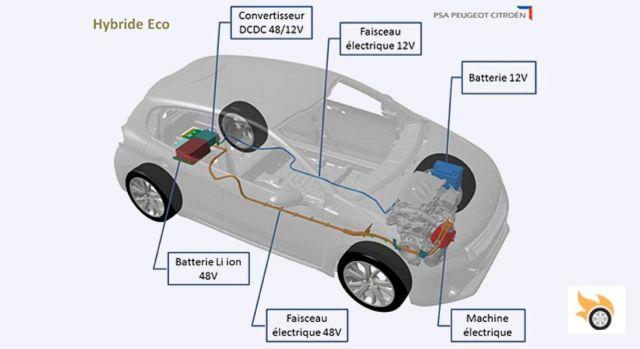
Microhybrid
Now we are going to talk about a term that generates controversy, because it is not very clear what kind of system it refers to. As a concept, we can define it as a system halfway between a conventional car and a hybrid, without an electric motor for traction. Therefore, within that definition many things fit.
What should it be in my opinion? Well, a system with the following components:
- Motor/Generator (Alternator)
- Auxiliary battery (12 V)
- Storage battery (48 V)
- DC/DC converter
- Consumers
- ECU electrical management
Thus, with the 48 V auxiliary system, some energy can be recovered during braking by charging the 48 V battery and then fed to the consumers, and even conventional belt-driven components can be replaced by electric ones, such as the air conditioning compressor. In this way, when the car stops at a traffic light, the cooling continues to work even when the engine is stopped.
The DC/DC converter changes the DC voltage from 48 V to 12 V in order to adapt it to the consumers. And vice versa, from 12 V to 48 V to recharge the battery. The alternator functions as a starter motor, providing start/stop functionality, and as a generator, to power the 12 V and 48 V system. All of this is managed by a dedicated ECU.
The 48V system offers the advantage of having more power, without having very high current values. For example, for a power of 3,000 W, at 12 V we would have a current of 250 A, which is a lot and would require very thick cable sections (greater weight and cost). On the other hand, with the same 3,000 W, at 48 V the current would drop to 62.5 A. Less current, thinner cables, lower weight and lower cost. That is why long distance energy transport is done at very high voltage.
This is something that was talked about a few years ago, with some prototypes: Peugeot 208 Hybride Eco or Audi iHEV, but as far as I know, it has not been taken to production. In fact, the first manufacturer to mass produce a model with 48V auxiliary system has been Audi in this year's SQ7 TDI. Another advantage of such a system is to be able to have more demanding consumers, such as electric turbochargers, and to reduce the weight of the wiring.
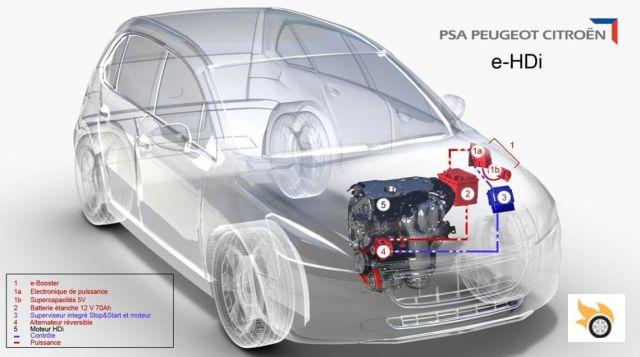
What is a micro-hybrid today? Well, nothing more than a car with a stop/start system and a more powerful battery. Its components, very similar to those of a conventional car, are as follows:
- Engine/Generator (alternator) or generator (alternator) + reinforced starter motor.
- Auxiliary battery (12V)
- Consumers
- ECU electrical management
Not to be confused with a Stop&Start, as for example Mazda's i-Stop uses "combustion energy" instead of an electric accumulator.
It is true that in this case PSA incorporates a small bank of supercapacitors. A supercapacitor is nothing more than a mix between a capacitor and a battery (more capacitor than battery), which is capable of delivering a very high current in a short time. Because of the size used by PSA, it is not used to accumulate a lot of energy. Its function is rather to avoid over-stressing the car's battery during start-ups, controlled at all times by the electrical management ECU, which monitors how charged the battery is. In this case, the alternator performs the functions of both starting and electricity generation.
What happens in summer when you stop at a traffic light? The air conditioning compressor stops working, and the temperature inside the car rises as a result. If it rises too much, the engine will start again. In winter the problem is less of a problem, because the waste heat from the air conditioning circuit is greater, and does not cause as much inconvenience.
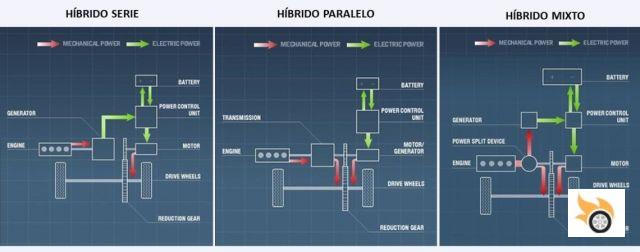
Hybrid
Now let's move on to the main course, as a hybrid is the one that has the maximum complexity, having to coordinate the thermal propulsion system with the electric one. Before describing the electrical system of a hybrid, we must say that there are three types of hybrids: series, parallel and mixed.
- Series hybrid: A series hybrid is basically an electric car, where the engine serves only as an electric generator. That is, the heat engine has no mechanical connection with the wheels. This concept taken to the extreme is called a range extender or electric range extender, such as Opel Ampera or the previous BMW i3, with an important difference: the primary engine is electric, the combustion engine is a simple generator.
- Parallel hybrid: A parallel hybrid does have a mechanical connection between the heat engine and the wheels, and can be propelled by the heat engine, the electric motor or both at the same time. The only drawback is that the heat engine does not recharge the traction battery.
- Mixed hybrid: The mixed hybrid solves this problem. The car can be driven by the heat engine, the electric motor, or both. And at the same time the heat engine is able to recharge the traction battery. This configuration is used by Toyota, Lexus, Volvo, Kia, Hyundai, Mitsubishi, Audi, BMW, Porsche, Mercedes, Volkswagen, etc.. As you can see, it is the most common.
From the point of view of the electric system, the three types have practically the same, with small exceptions. We will focus on the mixed hybrid for being the most common and which has all the complexity. The systems that it includes are:
- Auxiliary generator (alternator)
- Auxiliary battery (12 V)
- Main generator (auxiliary electric motor)
- Electric motor (traction)
- Electric Air Conditioning Compressor
- Electric Auxiliary Heater (PTC)
- Electric power steering
- Electric Servo Brake (vacuum pump or direct assist)
- Inverter / Controller
- BMS
- Bi-directional DC-DC converter (AT/BT)
- Traction battery (AT: 300 to 600 V)
- Traction battery air conditioning
- ECU electrical management
We are going to comment on each of them, leaving aside the alternator and the auxiliary battery, which we have already talked about.
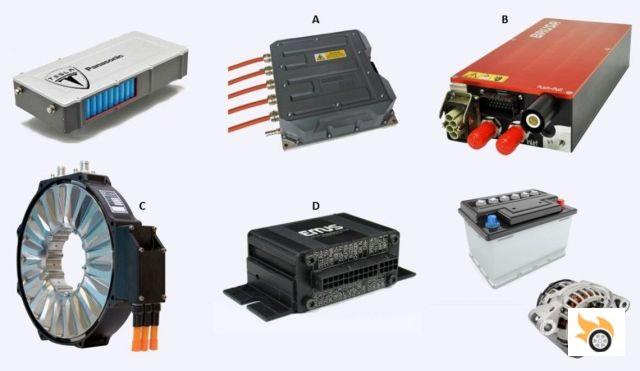
The main generator is coupled to the engine and is in charge of charging the battery, or generating electricity that will be instantly consumed by the electric motor, or both. It all depends on what is needed at any given moment.
The electric traction motor (C in the image), is usually of alternating current (AC) and is obviously mechanically coupled to the wheels, either directly or through a reduction gear. I mention an interesting manufacturer of electric motors: Yasa Motors. They are responsible for electrically propelling the Koenigsegg Regera. Or Fukuta. Rumor has it that it powers the Tesla, although Elon Musk has never confirmed (or denied).
If the car moves in 100% electric mode, the combustion engine doesn't work. What happens to the power steering, the brake servo, the air conditioning compressor or the heating? Well, they have to be electric. This adds a lot of complexity to the auxiliary systems. A PTC heater is usually used as an electric heater. And for the brake servo there are two ways: either with an electric pump that generates the necessary vacuum, or via an electric motor directly coupled to the brake master cylinder, just like the electric steering.
The power shuttle (A) is one of the most important parts of the system. It is responsible for driving the electric motor, converting the voltage provided by the traction battery into a voltage/current suitable for the motor. It is also in charge of "reading" the accelerator, to know what impulse the electric motor needs; and of performing the regeneration, taking into account how much we have pressed the brake. It is obviously a very complex electronic system, with hundreds of programmable parameters. This system is in close communication with the ECU of the electrical system. An inverter manufacturer? Sevcon.
Let's go now to the BMS or Battery Management System (D). In a hybrid or electric car, the battery already has hundreds of cells that need to be taken care of. That's what the BMS is for. It measures the voltage of each individual cell and cuts off the charge when it is full. So you have to run a cable to each cell from the BMS. It also equalizes the whole pack of cells. What is equalizing? It is simply equalizing the load between them. It is obvious that the cells are not perfect, and due to manufacturing tolerances, some will accept more load than others, or simply some will degrade sooner. This system is also in close communication with the ECU of the electrical system. A BMS manufacturer? Elektromotus with its EMUS.
Let's go now to the DC-DC converter (B). Since the battery will be High Voltage, we have to have some device to go from hundreds of volts to 12V, which runs all the auxiliary systems. This is done by the DC-DC converter. If it is bi-directional, it is also capable of converting 12V to hundreds of volts. An example of a manufacturer of components for electric vehicles, involved in competition: Brusa.
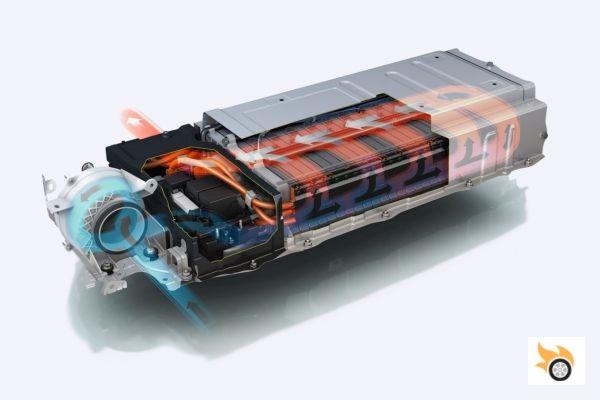
Let's talk about the star of the hybrid vehicle: the battery. It will be made up of hundreds of cells, and will have capacities of around 6-10 kW. Let's assume that one cell has 40 W of power. To make a 6 kW (6,000 W) battery, 150 cells will be needed. Depending on how we make the pack we will have more voltage, or more current.
Let's see an example: Toyota Prius 2016. From its specifications we have that its total combined power is 122 hp. And we see that the heat engine gives 98 hp and the electric motor 72 hp (53 kW), which added together are 170 hp. It doesn't match, does it? This is due to the maximum current that the battery can provide, which is below the power that the electric motor is capable of delivering, which in this case, subtracting 122 hp from the 98 hp of the heat engine, gives us 24 hp (17 kW). Let's use what we have explained above, to calculate some data of its battery.
The Prius' NiMH battery - there is another lithium-ion battery - has a total capacity of 1.3 kW, 201.6 V and 6.5 Ah. This means the electric motor will be using 17 kW / 201.6 V = 84 A. Therefore, we see that the Prius battery at maximum discharge is approximately 13C. If we do the inverse rule of three, at maximum discharge, the battery holds 6.5 Ah * 60 minutes / 84 A = 4.6 minutes.
Now let's calculate how many cells it has. Since NiMH cells are 1.2 V, dividing 201.6 V / 1.2 V = 168 cells in series. Since each prismatic cell in the Prius is 6.5 Ah, we see that your battery is 168S, with no cells in parallel.
The 201.6V voltage is nominal, but on charge it will be higher, and on discharge it will be lower. Let's see. The charging voltage of a NiMH cell is about 1.5V. If we multiply by the 168 cells in the pack we get that the Prius charges its battery at 252 V. The discharge voltage of a NiMH cell is about 1V. Therefore, the Prius will have its battery completely discharged when it reaches 168 V, a voltage it will never reach. Remember that the system will never allow it to go below 20% charge (175 V approximately), so that the battery will provide us with the cycles promised by the manufacturer.
The important thing when making a good hybrid or electric design, is to couple well all the elements, so that the battery and the electric motor work in conjunction.
One of the most critical systems in a hybrid is the climate control of the batteries. As we said before, it is important to keep them below 30 ºC and above 20 ºC, so that they offer good performance and durability. That is why manufacturers, apart from the cooling system of the thermal engine, have a second climate control system, only for the batteries and the electrical system (inverter and electric motor). Some manufacturers use battery ventilation (Toyota Prius) and others use something more elaborate and effective, with liquid cooling (Tesla Model S).
Finally, our conductor, the ECU of the electrical system, which must coordinate everything in good harmony: the BMS, charger, inverter, converter, etc.. It must know at all times the battery charge, and the selected driving program, in order to decide when to stop or start the thermal engine or recover energy during braking.
As you can see, a hybrid car is quite a complex system, which requires the design of systems that are certainly new to the automotive industry, with its strict quality standards.
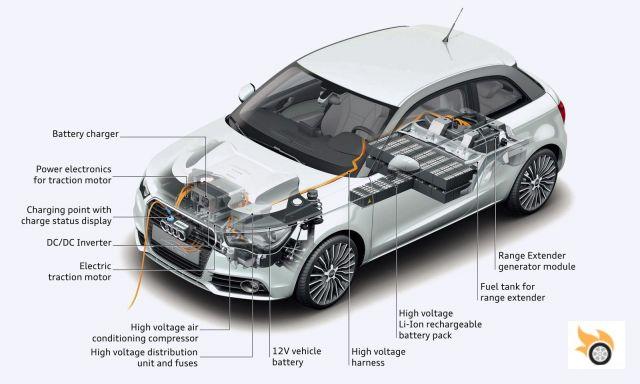
Plug-in hybrid
The plug-in hybrid is the same as the hybrid vehicle that we discussed in the previous section, except that it adds a charger and batteries of greater capacity (about 10 times higher). This charger can perform two functions. Firstly, it converts the alternating current/voltage from the normal household mains (AC) into direct current (DC) with the appropriate voltage to recharge the battery when it is plugged in, supervised by the BMS. If we use a fast charger, it will adapt the three phase current/voltage, which is more powerful, also to DC to recharge the battery faster.
On the other hand, it is possible that an adapted charger will directly provide the High Voltage in DC needed to recharge the battery, without any conversion. In this case the charger will do nothing, and the BMS will be in charge of supervising it.
In turn, the charger itself will power the auxiliary systems necessary for the recharging operation.
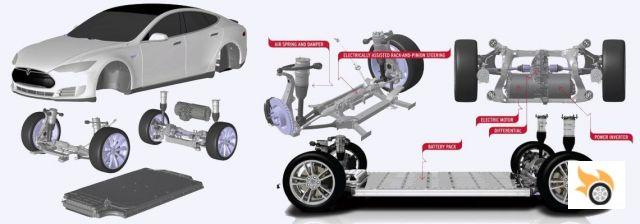
Pure electric
Once we have reached this point, what remains is to follow the following recipe: we take a plug-in hybrid and eliminate the thermal engine with its alternator and the main generator. This leaves us with a 100% electric car. Easy, isn't it? Some examples: Tesla Model S, Nissan Leaf, Renault Zoe, Chevrolet Bolt or the future Audi e-Tron SUV. To refresh your memory, we will list the systems they have:
- Auxiliary battery (12 V)
- Electric motor (traction)
- Electric Air Conditioning Compressor
- Electric auxiliary heater (PTC)
- Electric power steering
- Electric servo brake (vacuum pump or direct assistance)
- Inverter / Controller
- BMS
- Bi-directional DC-DC converter (AT/BT)
- AC/DC charger
- Traction battery (HV: 300 to 600 V)
- Traction battery air conditioning
- ECU electrical management
In this case, in the cycle part, we can have different variants, depending on the traction motors available: cars with one motor, two motors, three or four motors. Cars with a single engine will pass the power to a single axle, through some gear reducer / differential, such as the Nissan Leaf or Renault Zoe.
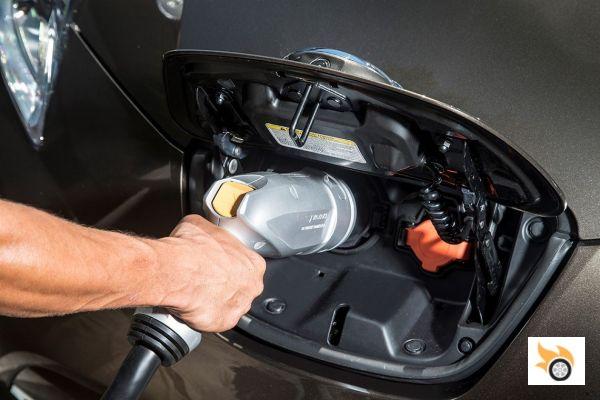
Those with two motors can have two variants: one motor on each axle, with gearing/differential, so we would have an all-wheel drive (like the Tesla Model S D version), or place the two motors on the same axle, one for each wheel, like the Koenigsegg Regera, which although it is not purely electric, uses this technique. In this case, the inverter/controller must perform an additional management: the differential, managing the torque of each electric motor, depending on multiple factors, including lateral and longitudinal accelerations and steering wheel rotation.
With three motors, the configuration of an axle is used, with one motor per wheel, and on the other axle a motor with a gearbox/differential group, like the future 100% electric Audi.
And finally, four motors, one for each wheel. Mechanically this is the simplest option, as it doesn't need gearing/differential, being all controlled by the inverter/controller. As far as I know, there is no production car of this type, although there were some prototypes, such as the Mercedes SLS AMG Electric Drive.
And if you've made it this far without getting bored, congratulations. You already know (almost) everything about the electric system of any car. Whether it's a conventional, hybrid or electric car, the most important thing is that it makes us enjoy driving it. That's why we are pistonudos.

























